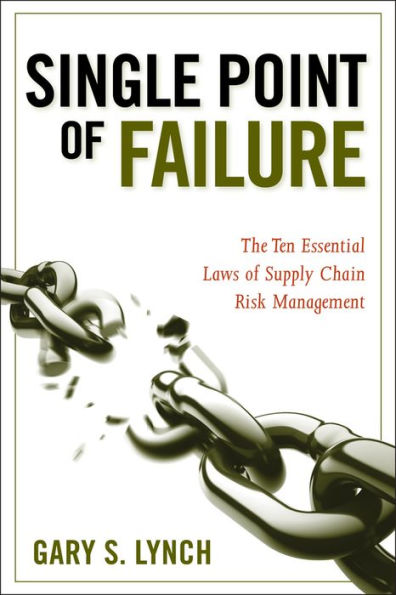It is mind-boggling to consider what it takes to produce the products we depend on—critical drugs like blood thinners, plastic-based products such as syringes, isotopes for medical imaging, and milk-based baby formula. Or maybe your livelihood depends on your ability to transport products, on your customers having access to your online order entry system, or on the timely receipt of parts from your suppliers on the other side of the world. The occurrence of a single point of failure—whether a product contamination, labor strike, trade credit crunch, an earthquake, or a health crisis—can interrupt the flow of goods and cause total systemic failure.
Written by internationally recognized industry veteran Gary Lynch, Single Point of Failure: The Ten Essential Laws of Supply Chain Risk Management reveals just that—the ten vital laws to successfully identifying, measuring, mitigating, and financing risk, with guidance for establishing your organization's supply risk management program, avoiding bad decisions, and gathering better information and data to make good decisions.
Here, you'll discover:
How to establish your organization's supply risk management program
Why no risk strategy is a solution for bad decisions
What causes supply chain risk management demand to trump supply
The sourcing strategies that create more risk, not less
Why managing the parts does not equal managing the whole
What the best policy is for knowing what's in your policy
Believing that all is well is a self-deception. You need to continually analyze and evaluate the risks to your supply chains and business networks, determine and learn the root cause of problems, and decide whether you have the proper philosophy, culture, and systems in place to identify, measure, mitigate, and finance risk. Addressing risk from several points of view, Single Point of Failure authoritatively guides you in how to remain agile to avoid risk, be resilient to respond, adapt and absorb risk, develop methodologies that are sustainable to scale, and maintain risk solutions.
It is mind-boggling to consider what it takes to produce the products we depend on—critical drugs like blood thinners, plastic-based products such as syringes, isotopes for medical imaging, and milk-based baby formula. Or maybe your livelihood depends on your ability to transport products, on your customers having access to your online order entry system, or on the timely receipt of parts from your suppliers on the other side of the world. The occurrence of a single point of failure—whether a product contamination, labor strike, trade credit crunch, an earthquake, or a health crisis—can interrupt the flow of goods and cause total systemic failure.
Written by internationally recognized industry veteran Gary Lynch, Single Point of Failure: The Ten Essential Laws of Supply Chain Risk Management reveals just that—the ten vital laws to successfully identifying, measuring, mitigating, and financing risk, with guidance for establishing your organization's supply risk management program, avoiding bad decisions, and gathering better information and data to make good decisions.
Here, you'll discover:
How to establish your organization's supply risk management program
Why no risk strategy is a solution for bad decisions
What causes supply chain risk management demand to trump supply
The sourcing strategies that create more risk, not less
Why managing the parts does not equal managing the whole
What the best policy is for knowing what's in your policy
Believing that all is well is a self-deception. You need to continually analyze and evaluate the risks to your supply chains and business networks, determine and learn the root cause of problems, and decide whether you have the proper philosophy, culture, and systems in place to identify, measure, mitigate, and finance risk. Addressing risk from several points of view, Single Point of Failure authoritatively guides you in how to remain agile to avoid risk, be resilient to respond, adapt and absorb risk, develop methodologies that are sustainable to scale, and maintain risk solutions.

Single Point of Failure: The 10 Essential Laws of Supply Chain Risk Management
320
Single Point of Failure: The 10 Essential Laws of Supply Chain Risk Management
320Related collections and offers

